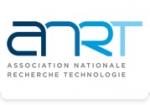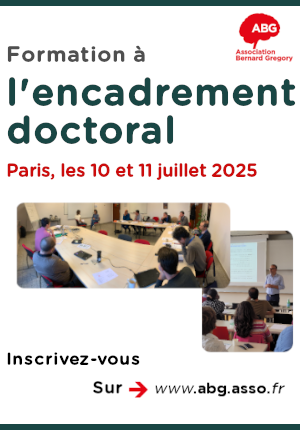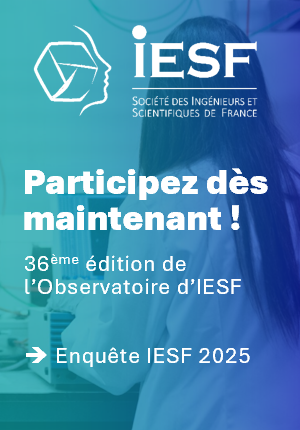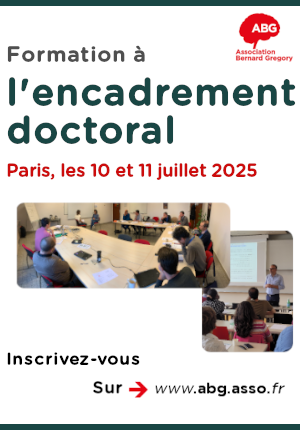Cellules photovoltaïques organiques transparentes à haute performance : exploration du rôle de l'ingénierie optique // High-performance transparent organic photovoltaics: exploring the role of optical engineering
|
ABG-131115
ADUM-65204 |
Thesis topic | |
| 2025-04-16 |
Université de Lille
Villeneuve d'Ascq - France
Cellules photovoltaïques organiques transparentes à haute performance : exploration du rôle de l'ingénierie optique // High-performance transparent organic photovoltaics: exploring the role of optical engineering
- Computer science
photovoltaïque organique, photonique, plasmonique métal-oxyde, fabrication salle blanche, caractérisation optique, machine learning
Organic photovoltaics, photonics, metal-oxyde plasmonics, Clean-room nanofabrication, Optical caracterisation, Machine learning
Organic photovoltaics, photonics, metal-oxyde plasmonics, Clean-room nanofabrication, Optical caracterisation, Machine learning
Topic description
Le photovoltaïque intégré aux bâtiments est un domaine émergent de la recherche sur les énergies renouvelables, susceptible d'améliorer considérablement l'efficacité énergétique des bâtiments, de relever les défis de l'urbanisation mondiale et de contribuer à l'objectif de neutralité carbone. Il repose sur l'utilisation de cellules solaires organiques dont la transparence est assurée par les bandes d'absorption sélectives des semi-conducteurs organiques (ST-OPV). Cette transparence leur confère l'avantage unique d'être facilement intégrées aux vitrages des bâtiments contrairement aux cellules opaques constituées de matériaux inorganiques tels que le silicium. Cette thèse se concentrera sur le développement de ST-OPV à haute performance, avec un accent particulier sur l'utilisation de l'ingénierie optique pour améliorer l'efficacité du dispositif. La candidate ou le candidat explorera des stratégies d'ingénierie optique avancées visant à améliorer l'absorption de la lumière infrarouge tout en maintenant une transparence élevée dans le visible, critère déterminant pour pouvoir intégrer ces dispositifs dans les façades et les fenêtres de bâtiments.
La thèse couvre les éléments suivants :
- Conception optique à haut rendement pour le ST-OPV : ce volet se concentre sur le développement d'un modèle d'analyse optique permettant l'optimisation d'un nombre important de paramètres des ST-OPV, en cherchant le meilleur compromis entre différents indicateurs de performance. En combinant les prédictions théoriques avec une validation expérimentale réalisée à l'université de Shanghai, l'étude vise à améliorer l'absorption dans le proche infrarouge et la transparence dans le visible, et ainsi prédire les structures optimales pour un ST-OPV à haute performance.
- La simulation du couplage entre les propriétés plasmoniques de nanostructures d'oxydes métalliques et la couche photoactive de ST-OPVs: cet axe vise à explorer l'incorporation de nanostructures plasmoniques d'oxydes métalliques dans la couche photoactive afin d'améliorer son absorption de la lumière dans le proche infrarouge tout en maintenant la transparence de la lumière visible. Ces nanostructures, accordables par dopage, sont de tailles suffisamment petites par rapport à l'épaisseur de la couche photoactive et d'une grande stabilité chimique. Leur géométrie sera choisie pour maximiser les propriétés de diffusion omnidirectionnelles de la lumière.
------------------------------------------------------------------------------------------------------------------------------------------------------------------------
------------------------------------------------------------------------------------------------------------------------------------------------------------------------
Building-integrated photovoltaics is an emerging field in renewable energy research, with the potential to significantly improve the energy efficiency of buildings, address the challenges of global urbanization, and contribute to the goal of carbon neutrality. It relies on the use of organic solar cells whose transparency is ensured by the selective absorption bands of organic semiconductors (ST-OPV). This transparency gives them the unique advantage of being easily integrated into building glazing, unlike opaque cells made of inorganic materials such as silicon. This thesis will focus on the development of high-performance ST-OPV, with a particular emphasis on the use of optical engineering to improve device efficiency. The candidate will explore advanced optical engineering strategies aimed at enhancing infrared light absorption while maintaining high transparency in the visible range, a crucial criterion for integrating these devices into building facades and windows.
The thesis covers the following elements:
- High-efficiency optical design for ST-OPV: This section focuses on developing an optical analysis model to optimize a large number of ST-OPV parameters, seeking the best trade-off between different performance indicators. By combining theoretical predictions with experimental validation conducted at the University of Shanghai, the study aims to improve absorption in the near-infrared and transparency in the visible range, thereby predicting optimal structures for high-performance ST-OPV.
- Simulation of the coupling between the plasmonic properties of metal oxide nanostructures and the photoactive layer of ST-OPVs: This axis aims to explore the incorporation of plasmonic metal oxide nanostructures into the photoactive layer to enhance its absorption of near-infrared light while maintaining visible light transparency. These nanostructures are tunable through doping, sufficiently small in size relative to the thickness of the photoactive layer, and have high chemical stability. Their geometry will be chosen to maximize the omnidirectional light scattering properties.
------------------------------------------------------------------------------------------------------------------------------------------------------------------------
------------------------------------------------------------------------------------------------------------------------------------------------------------------------
Début de la thèse : 01/10/2025
La thèse couvre les éléments suivants :
- Conception optique à haut rendement pour le ST-OPV : ce volet se concentre sur le développement d'un modèle d'analyse optique permettant l'optimisation d'un nombre important de paramètres des ST-OPV, en cherchant le meilleur compromis entre différents indicateurs de performance. En combinant les prédictions théoriques avec une validation expérimentale réalisée à l'université de Shanghai, l'étude vise à améliorer l'absorption dans le proche infrarouge et la transparence dans le visible, et ainsi prédire les structures optimales pour un ST-OPV à haute performance.
- La simulation du couplage entre les propriétés plasmoniques de nanostructures d'oxydes métalliques et la couche photoactive de ST-OPVs: cet axe vise à explorer l'incorporation de nanostructures plasmoniques d'oxydes métalliques dans la couche photoactive afin d'améliorer son absorption de la lumière dans le proche infrarouge tout en maintenant la transparence de la lumière visible. Ces nanostructures, accordables par dopage, sont de tailles suffisamment petites par rapport à l'épaisseur de la couche photoactive et d'une grande stabilité chimique. Leur géométrie sera choisie pour maximiser les propriétés de diffusion omnidirectionnelles de la lumière.
------------------------------------------------------------------------------------------------------------------------------------------------------------------------
------------------------------------------------------------------------------------------------------------------------------------------------------------------------
Building-integrated photovoltaics is an emerging field in renewable energy research, with the potential to significantly improve the energy efficiency of buildings, address the challenges of global urbanization, and contribute to the goal of carbon neutrality. It relies on the use of organic solar cells whose transparency is ensured by the selective absorption bands of organic semiconductors (ST-OPV). This transparency gives them the unique advantage of being easily integrated into building glazing, unlike opaque cells made of inorganic materials such as silicon. This thesis will focus on the development of high-performance ST-OPV, with a particular emphasis on the use of optical engineering to improve device efficiency. The candidate will explore advanced optical engineering strategies aimed at enhancing infrared light absorption while maintaining high transparency in the visible range, a crucial criterion for integrating these devices into building facades and windows.
The thesis covers the following elements:
- High-efficiency optical design for ST-OPV: This section focuses on developing an optical analysis model to optimize a large number of ST-OPV parameters, seeking the best trade-off between different performance indicators. By combining theoretical predictions with experimental validation conducted at the University of Shanghai, the study aims to improve absorption in the near-infrared and transparency in the visible range, thereby predicting optimal structures for high-performance ST-OPV.
- Simulation of the coupling between the plasmonic properties of metal oxide nanostructures and the photoactive layer of ST-OPVs: This axis aims to explore the incorporation of plasmonic metal oxide nanostructures into the photoactive layer to enhance its absorption of near-infrared light while maintaining visible light transparency. These nanostructures are tunable through doping, sufficiently small in size relative to the thickness of the photoactive layer, and have high chemical stability. Their geometry will be chosen to maximize the omnidirectional light scattering properties.
------------------------------------------------------------------------------------------------------------------------------------------------------------------------
------------------------------------------------------------------------------------------------------------------------------------------------------------------------
Début de la thèse : 01/10/2025
Funding category
Funding further details
Financement d'un établissement public Français
Presentation of host institution and host laboratory
Université de Lille
Institution awarding doctoral degree
Université de Lille
Graduate school
632 ENGSYS Sciences de l'ingénierie et des systèmes
Candidate's profile
La candidate ou le candidat devra avoir idéalement des bases solides en électromagnétisme, nanooptique, physique du solide, ainsi des compétences en informatique, notamment ce qui concerne les méthodes d'apprentissage par machine learning. Une expérience de fabrication en salle blanche et de caractérisation est également souhaitable.
The candidate should ideally have a strong foundation in electromagnetism, nano-optics, solid-state physics, as well as computer skills, particularly in machine learning methods. Experience in cleanroom fabrication and characterization is also desirable.
The candidate should ideally have a strong foundation in electromagnetism, nano-optics, solid-state physics, as well as computer skills, particularly in machine learning methods. Experience in cleanroom fabrication and characterization is also desirable.
2025-05-04
Apply
Close
Vous avez déjà un compte ?
Nouvel utilisateur ?
More information about ABG?
Get ABG’s monthly newsletters including news, job offers, grants & fellowships and a selection of relevant events…
Discover our members
 Nokia Bell Labs France
Nokia Bell Labs France  CASDEN
CASDEN  ASNR - Autorité de sûreté nucléaire et de radioprotection - Siège
ASNR - Autorité de sûreté nucléaire et de radioprotection - Siège  Institut Sup'biotech de Paris
Institut Sup'biotech de Paris  Aérocentre, Pôle d'excellence régional
Aérocentre, Pôle d'excellence régional  ANRT
ANRT  Ifremer
Ifremer  Groupe AFNOR - Association française de normalisation
Groupe AFNOR - Association française de normalisation  MabDesign
MabDesign  MabDesign
MabDesign  Laboratoire National de Métrologie et d'Essais - LNE
Laboratoire National de Métrologie et d'Essais - LNE  PhDOOC
PhDOOC  ONERA - The French Aerospace Lab
ONERA - The French Aerospace Lab  SUEZ
SUEZ  Généthon
Généthon  Tecknowmetrix
Tecknowmetrix  CESI
CESI  TotalEnergies
TotalEnergies  ADEME
ADEME





